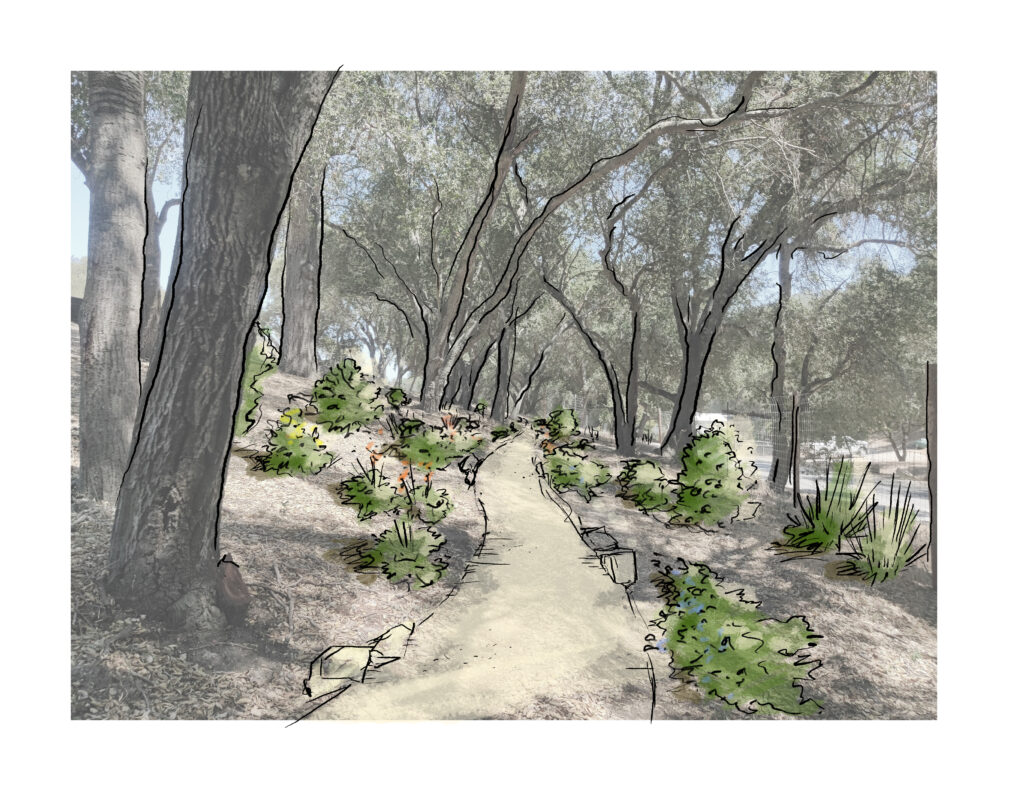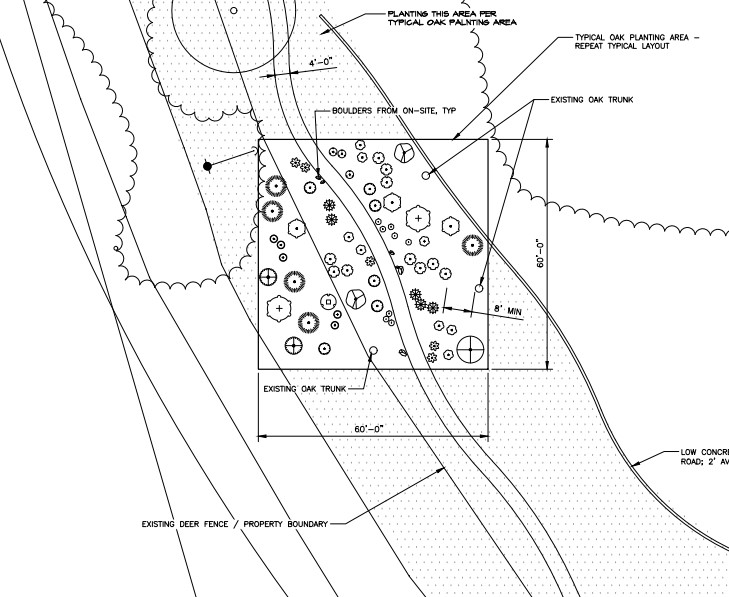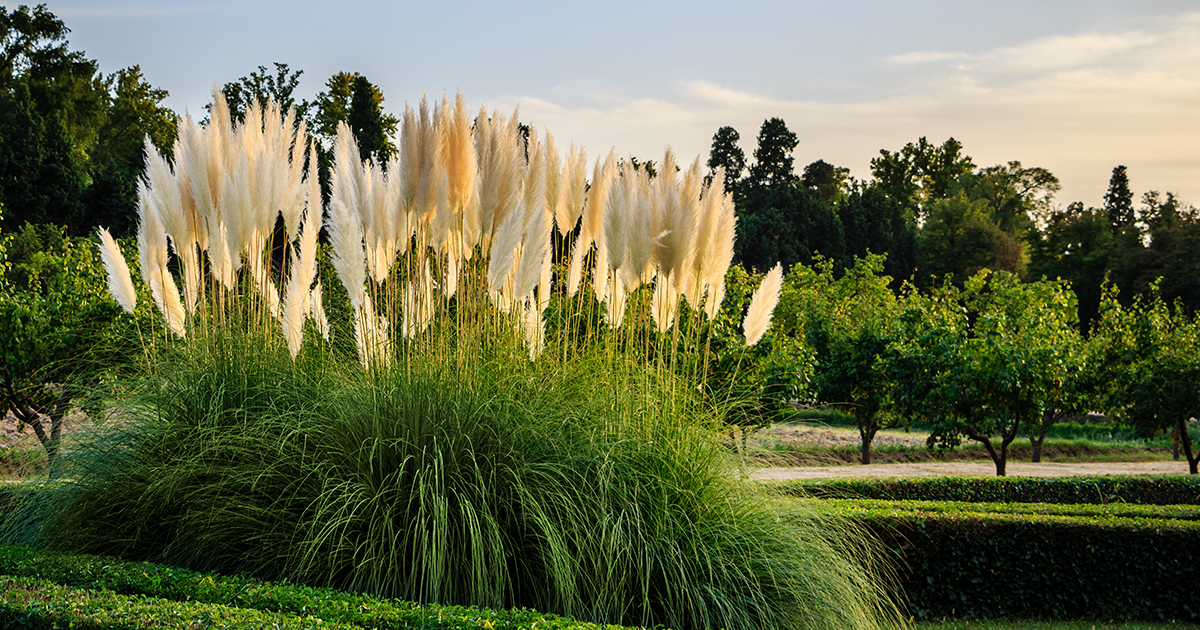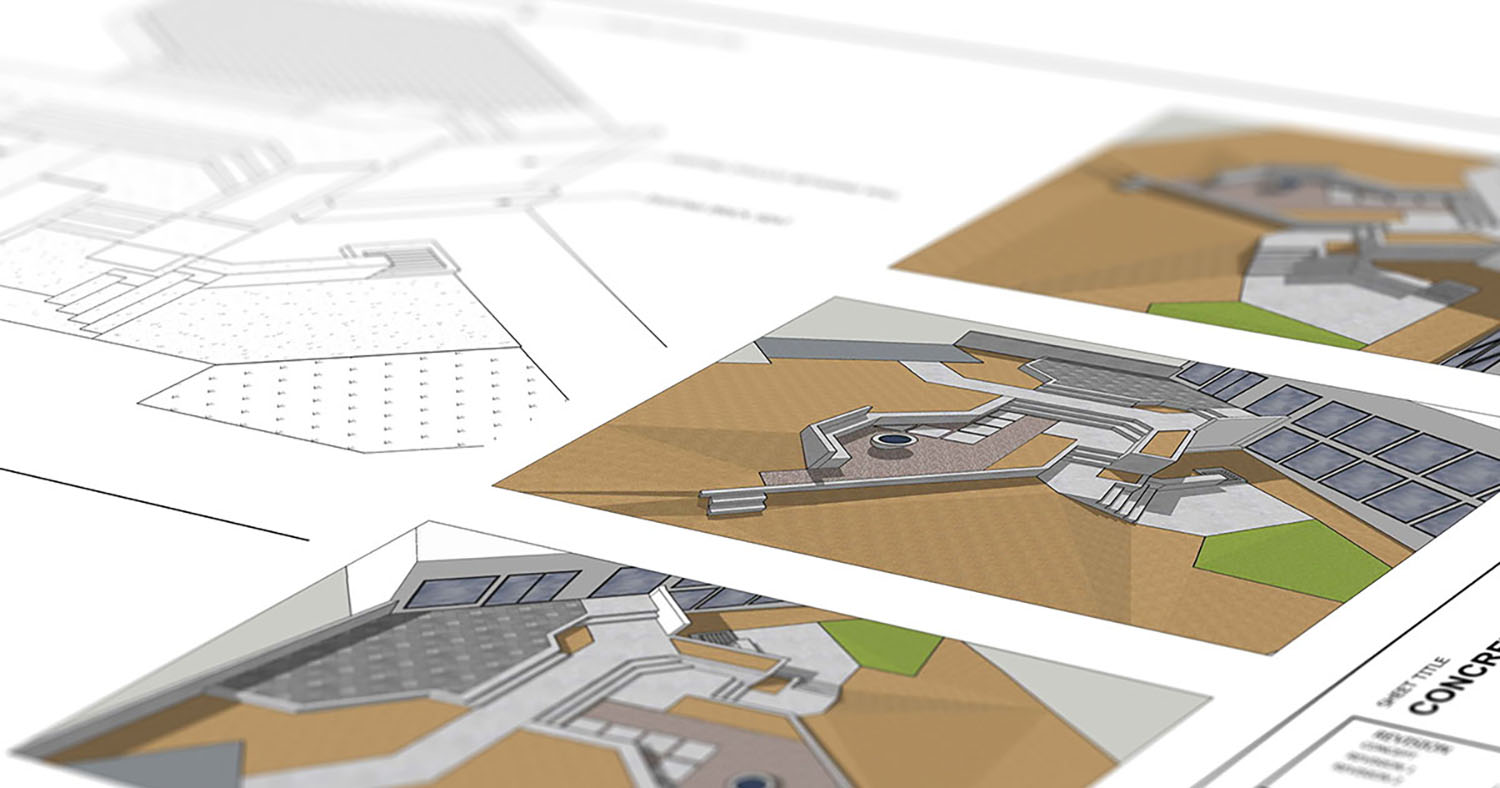
Sep 1, 2022
The Maison Mason Vineyard in West Paso Robles is a native oak grove paradise backdropped by classic sweeping grapevine rows. Madrone was tasked with designing a formal entry and establishing the native oak understory. We achieved the former through a dense planting around a new automatic entry gate, low board-form concrete walls, and select ornamental planting along the main road and entry drive. The latter goal was executed by locating a palette of native species on-site throughout the understory area, balancing long-lived foundation plants in a harsh climate with seasonal interest and lush variety in key areas.

Due to a steep cut slope bordering the entry drive, strategic planting selections targeted aesthetic and erosion concerns with native plant species that would spread and drape across the area. Brightly colored flower species stipple the palette and create the perfect drive up to sweeping vistas and a future development location.

We designed irrigation and low voltage lighting systems throughout the new landscapes to achieve longevity for this beautiful grove and entry, inviting guests to come and enjoy all that the vineyard offers.




Want more information on our vineyard design services? Contact our landscape designers at [email protected] or (805) 466-6263.

Jul 11, 2022
As a landscaping company that bases our work and design on the native flora palette, we typically make recommendations for plants rather than censures. There are, however, many plants that should be outright avoided in our Central Coast landscapes, or at the very least, used sparingly.
There are “invasive” and “introduced” plants. The latter category acknowledges flora introduced to a region that complements or makes room for native, local plant life without detrimental competition. Invasive plants, on the other hand, choke out native plant life and, subsequently, lead to breakdown of native fauna as well. Overall, invasive plants upset the balance of local ecosystems, reducing local biodiversity and often eventually leading to native endangerment and unhealthy, uncontrollable landscapes.
Conscientious planting has a greater impact than we can express, so we’ve made a small list of plants to avoid in landscape planting overall, but especially in commercial properties and HOA communities.
Nasella tenuisima (Mexican Feather Grass)

While it is known for its delicacy and graceful fronds, Mexican Feather Grass is a highly invasive grass species for the California region. It produces tens of thousands of seeds and can continue to be invasive even five years after removal due to contaminated soils. In windy environments, it seeds readily and therefore “self-sows,” making it very difficult to prevent its spread as it crowds out other native grasses and invades neighboring landscapes. This plant cannot be contained and should not be planted regardless of aesthetic appeal; we highly recommend exploring Central California’s native grasses and the gracefulness that can be found there.
Cortaderia selloana (Pampas Grass)

With its silvery plumes and commanding height, Pampas Grass is lovely but another highly invasive grass species. Quick to grow and dominate, the Pampas Grass is insidiously ubiquitous in Big Sur landscapes and has transformed beautiful coastal areas to drab and ill-fitting prairies. Similar to Mexican Feather Grass, Pampas Grass is nearly impossible to contain and should be discouraged in all landscapes.
Euphorbia (Spurge)

A diverse genus of flowering plants, Euphorbia contains several species that are known to be invasive. Confirm before planting to avoid spreading harmful non-natives. Euphorbia terracina, Euphorbia virgata, Euphorbia obloganta, and Euphorbia lathyris are all examples of invasive spurges, but are not an exhaustive list.
Rhomneya coulteri (Matilja Poppy)

Some natives are more dominating than others, and the Matilja Poppy qualifies. With fluffy, white-and-yellow flowers on bushes that can grow to tower, the Matilja Poppy should be planted with awareness and caution. Though it cannot be counted as invasive, this showy California native has a tendency to run in the garden setting, spreading in ways that are difficult to control and choking out other less assertive plants. Provide root containment or make sure it has adequate space within the garden in order to prevent its domineering personality from becoming an issue.
Ailanthus altissima (Tree of Heaven)
 Contrary to its angelic name, the Tree of Heaven is a highly aggressive non-native tree. Luckily, it is not quite so popular in planting palettes due to its offensive smell; however, its hardiness and lack of insect or disease problems still makes it a dangerous contender for many properties. A quick reproducer, it is known to stifle or even kill native species, secreting chemicals into the soil that are toxic to surrounding plants. Largely uncontrollable, we urge anyone to consider better-smelling, native trees that are just as hardy.
Contrary to its angelic name, the Tree of Heaven is a highly aggressive non-native tree. Luckily, it is not quite so popular in planting palettes due to its offensive smell; however, its hardiness and lack of insect or disease problems still makes it a dangerous contender for many properties. A quick reproducer, it is known to stifle or even kill native species, secreting chemicals into the soil that are toxic to surrounding plants. Largely uncontrollable, we urge anyone to consider better-smelling, native trees that are just as hardy.

May 2, 2022
This project maximizes a picturesque 6,000 SF backyard in the Los Osos hills with stately oaks and across-the-valley views. The design entirely re-envisions the patchwork and dated existing landscape, revitalizing it as a family-friendly hangout suitable for kids and adults.

The redwood fencing and gate delineate the overall space, while large format pavers provide an elegant walkway. A sand play pit and trampoline location provide entertainment areas for younger folks, while a hot tub and fire pit evoke warmth for cool Los Osos evenings. Water trough garden beds, citrus trees, and an outdoor shower provide for daytime activity.

With a significant elevation across the site, multiple elevation changes help to define rather than divide the space, increasing the area of usable landscape adjacent to the kitchen and front entry, and opening to the natural hillside beyond.
Taking inspiration from the elegant architecture of the residence, a series of 90-degree and 45-degree angles define paths of travel within the landscape, including the approach to the front door. Multi-level seating, lawn space, and retaining walls lend to the modern feel of the design.

Madrone designers made use of new Sketchup modeling and Lumion rendering abilities to assist the owners in visualizing the site elevations and general character.
Want more information on our landscape design services? Contact our landscape designers at [email protected] or (805) 466-6263.

Apr 10, 2022
With a modern design style, this family retreat features patio spaces, a deck, fireplace, water feature, lawn, play area, hot tub, retaining walls, and railing.
The main vision for this Paso Robles landscape design was to create terraced levels to accommodate family and entertain guests. This was naturally achieved using the landscape’s significant slope, which simultaneously introduced challenges and invited the opportunity for both integrated and distinctly separate spaces. With retaining walls in place and a design featuring railings and gates for the safety of children, we prioritized creating a secure design without sacrificing beauty and the natural aesthetics of the landscape.
The entertainment patio is tucked into a transitional space between an upper play area and lower deck. A fireplace and water weir feature frame two of its sides leaving it open on the third side to views of a native oak woodland.
The landscape’s functional and striking modern style was created using clean lines and uniform design elements such as concrete, cable rails, and a simple plant palette.















 Contrary to its angelic name, the Tree of Heaven is a highly aggressive non-native tree. Luckily, it is not quite so popular in planting palettes due to its offensive smell; however, its hardiness and lack of insect or disease problems still makes it a dangerous contender for many properties. A quick reproducer, it is known to stifle or even kill native species, secreting chemicals into the soil that are toxic to surrounding plants. Largely uncontrollable, we urge anyone to consider better-smelling, native trees that are just as hardy.
Contrary to its angelic name, the Tree of Heaven is a highly aggressive non-native tree. Luckily, it is not quite so popular in planting palettes due to its offensive smell; however, its hardiness and lack of insect or disease problems still makes it a dangerous contender for many properties. A quick reproducer, it is known to stifle or even kill native species, secreting chemicals into the soil that are toxic to surrounding plants. Largely uncontrollable, we urge anyone to consider better-smelling, native trees that are just as hardy.











